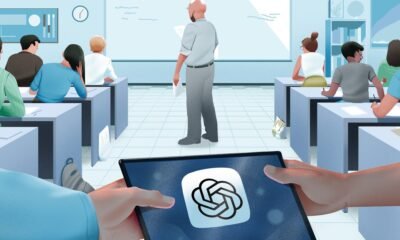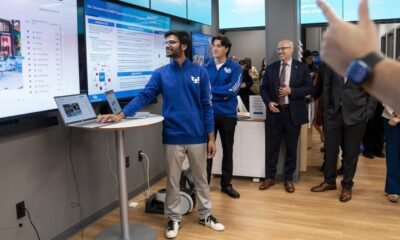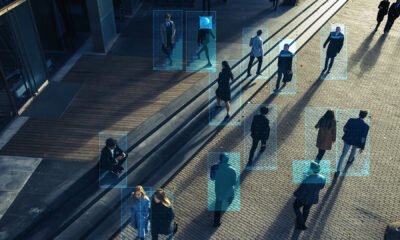AI Research
AI just gave researchers deeper understanding of Chesapeake Bay watershed

To map the Chesapeake Bay watershed, researchers have long relied on aerial imagery, a time-consuming process to document every water source. But artificial intelligence is changing that.
To map the Chesapeake Bay watershed, researchers have long relied on aerial imagery, a time-consuming process to document every water source. But artificial intelligence just might help to change that.
Researchers at the University of Maryland, Baltimore County, along with the Environmental Protection Agency and Chesapeake Conservancy, used high resolution photos and AI to study the watershed so closely that they could detect changes in elevation along every square meter. In doing so, they were able to increase the number of documented stream miles in the watershed from about 100,000 miles to more than 200,000 miles.
It’s the most precise picture yet of how even the smallest drops of water eventually make their way into the bay.
“The way that most people have done this in the past is to use very detailed aerial photographs and to look for evidence of streams in those photographs, and even then, it would be a lot of work to manually set eyes on every single channel,” said Matthew Baker, professor of geography and environmental systems at the University of Maryland, Baltimore County. “So the idea is to let the computer do that work for you.”
This provided Baker and others a way to identify streams and stream beds that might often be dry, but under certain circumstances, such as when it rains, they become the starting point for where water, as well as any pollutants or sediment, might come from.
“In many headwater locations, the streams aren’t flowing all the time, and so the channels exist as small gullies or depressions, and sometimes they’re wetlands,” Baker said. “We don’t think of them as stream channels.
“There’s this understanding that stream networks have many small branches that are often not mapped, and that we felt as we increase the resolution and the precision of our mapping process, we would see a lot more channels. And we did,” he added. “That’s consistent with probably what we would have expected when we started this process.”
The computer algorithm visualizes the terrain in the same way as if someone was there in person — analyzing the terrain, underground drainage systems and stormwater outflows.
“Because almost everything the population in the bay watershed does influences how water gets to streams, and the way that water gets to streams and what it carries with it — whether it’s pollutants, sediment or just the energy — can influence the condition of downstream water bodies, streams and rivers, and ultimately, what happens in the bay watershed.”
“So there is a connection between what happens in the landscape and what happens in the bay, and that’s part of the reason that it’s taken a long time to restore the bay,” he added. “That population has continued to increase and our manipulation of the landscape has continued to increase.”
But having a more precise mapping of where the water is flowing as it eventually makes it way to the bay can then inform state and local governments on land use and how the land is developed. It might also make you rethink how you shape the land you own.
“There are many places in the bay where nitrogen and phosphorus, or even sediment forwarded to the bay in small streams,” Baker said. “Sometimes it’s very difficult to know exactly where those are coming from, and one of the key pieces of information to make that assessment correctly is knowing where the flow paths are, where the stream channels are that can carry those pollutants.”
It also might help detect future flooding issues.
“Because those streams aren’t always flowing, we sometimes forget that they are an important part of the drainage network. And so humans, on purpose or inadvertently, sometimes will develop over them, put bridges over them, roads that block those flow paths,” he said. “So having those stream channels mapped, having the valleys that convey those floodwaters mapped, can be a useful resource for better planning in the future.”
Get breaking news and daily headlines delivered to your email inbox by signing up here.
© 2025 WTOP. All Rights Reserved. This website is not intended for users located within the European Economic Area.
AI Research
School Cheating: Research Shows AI Has Not Increased Its Scale

Changes in Learning: Cheating and Artificial Intelligence
When reading the news, one gets the impression that all students use artificial intelligence to cheat in their studies. Headlines in newspapers such as The Wall Street Journal or the New York Times often mention ‘cheating’ and ‘AI’. Many stories, similar to a publication in New York Magazine, describe students who openly testify about using generative AI to complete assignments.
With the rise of such headlines, it seems that education is under threat: traditional exams, readings, and essays are filled with cheating through AI. In the worst cases, students use tools like ChatGPT to write complete works.
This seems frustrating, but such a thought is only part of the story.
Cheating has always existed. As an educational researcher studying cheating with AI, I can assert that preliminary data indicate that AI has changed the methods of cheating, but not its volumes.
Our early data suggest that AI has changed the method, but not necessarily the scale of cheating that was already taking place.
This does not mean that cheating using AI is not a serious problem. Important questions are raised: Will cheating increase in the future due to AI? Is the use of AI in education cheating? How should parents and schools respond to prepare children for a life that is significantly different from our experience?
The Pervasiveness of Cheating
Cheating has existed for a very long Time — probably since the creation of educational institutions. In the 1990s and 2000s, Don McCabe, a business school professor at Rutgers University, recorded high levels of cheating among students. One of his studies showed that up to 96% of business students admitted to engaging in ‘cheating behavior’.
McCabe used anonymous surveys where students had to indicate how often they engaged in cheating. This allowed for high cheating rates, which varied from 61.3% to 82.7% before the pandemic.
Cheating in the AI Era
Has cheating using AI increased? Analyzing data from over 1900 students from three schools before and after the introduction of ChatGPT, we found no significant changes in cheating behavior. In particular, 11% of students used AI to write their papers.
Our diligent work showed that AI is becoming a popular tool for cheating, but many questions remain to be explored. For example, in 2024 and 2025, we studied the behavior of another 28000-39000 students, where 15% admitted to using AI to create their work.
Challenges of Using AI
Students are accustomed to using AI but understand that there are boundaries between acceptable and unacceptable use. Reports indicate that many use AI to avoid doing homework or to gain ideas for creative work.
Students feel that their teachers use AI, and many consider it unfair when they are punished for using AI in education.
What Will AI Use Mean for Schools?
The modern education system was not designed with generative AI in mind. Traditionally, educational tasks are seen as the result of intensive work, but now this work is increasingly blurred.
It is important to understand what the main reasons for cheating are, how it relates to stress, time management, and the curriculum. Protecting students from cheating is important, but ways of teaching and the use of AI in classrooms also need to be rethought.
Four Future Questions
AI has not caused cheating in educational institutions but has only opened new possibilities. Here are questions worth considering:
- Why do students resort to cheating? The stress of studying may lead them to seek easier solutions.
- Do teachers adhere to their rules? Hypocrisy in demands on students can shape false perceptions of AI use in education.
- Are the rules concerning AI clearly stated? Determining the acceptability of AI use in education may be vague.
- What is important for students to know in a future rich in AI? Educational methods must be timely adapted to the new reality.
The future of education in the age of AI requires an open dialogue between teachers and students. This will allow for the development of new skills and knowledge necessary for successful learning.
AI Research
Artificial intelligence helps break barriers for Hispanic homeownership | National News

We recognize you are attempting to access this website from a country belonging to the European Economic Area (EEA) including the EU which
enforces the General Data Protection Regulation (GDPR) and therefore access cannot be granted at this time.
For any issues, call (641) 684-4611.
AI Research
Artificial intelligence helps break barriers for Hispanic homeownership – Temple Daily Telegram
-

 Business6 days ago
Business6 days agoThe Guardian view on Trump and the Fed: independence is no substitute for accountability | Editorial
-
Tools & Platforms3 weeks ago
Building Trust in Military AI Starts with Opening the Black Box – War on the Rocks
-

 Ethics & Policy1 month ago
Ethics & Policy1 month agoSDAIA Supports Saudi Arabia’s Leadership in Shaping Global AI Ethics, Policy, and Research – وكالة الأنباء السعودية
-

 Events & Conferences4 months ago
Events & Conferences4 months agoJourney to 1000 models: Scaling Instagram’s recommendation system
-

 Jobs & Careers2 months ago
Jobs & Careers2 months agoMumbai-based Perplexity Alternative Has 60k+ Users Without Funding
-

 Education2 months ago
Education2 months agoVEX Robotics launches AI-powered classroom robotics system
-

 Funding & Business2 months ago
Funding & Business2 months agoKayak and Expedia race to build AI travel agents that turn social posts into itineraries
-

 Podcasts & Talks2 months ago
Podcasts & Talks2 months agoHappy 4th of July! 🎆 Made with Veo 3 in Gemini
-

 Podcasts & Talks2 months ago
Podcasts & Talks2 months agoOpenAI 🤝 @teamganassi
-

 Education2 months ago
Education2 months agoAERDF highlights the latest PreK-12 discoveries and inventions




















